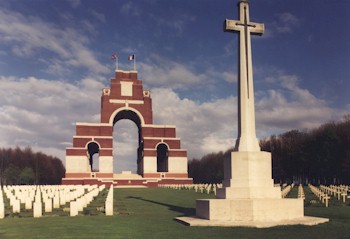|
|
| Home Topics Memorials Miscellany Transcripts References Family History Glossary Latest Beeston Blog About us | Site Search |
|
William Henry Bywater was born in Beeston in 1894 2, the only son of John Joseph (b. 1868, Beeston) and Harriett Bywater (b. c1870, Beeston, née Butler). In 1870, Harriett died leaving John bringing up two young children, living at 30 Union Street, Beeston while continuing to work as an iron turner3. In the next few years, certainly by 1905 he took the tenancy of the Rose Inn, a beerhouse on Middle Street, Beeston, on the corner of Moore Gate, where the family is to be found in 1911. His widowed mother was living with the family and, by then, William had started work as an instrument maker at the Ericsson Telephone Works in Beeston4. In 1913, The Rose licence was canceled as part of a rationisation of the number of existing licences in Beeston and John took over the tenancy of The Star, nearby on Middle Street. Soon after war came in August, 1914, William enlisted with the Kings Own Yorkshire Light Infantry, joining its 8th Battalion, formed at Pontefract in September 1914, one of eight New Army Service battalions raised by the Regiment in the early months of the war. After early training, while stationed at Frensham, Aldershot, Hythe and Bordon, he embarked with the regiment as reinforcements to the Expeditionary Force in France, arriving in Boulogne on 26 August 1915 as part of 70th Brigade 23rd Division5. By the last days of June 1916, the Battalion was part of the preparations for what was to be the great Somme offensive against the German held Leipzig Salient. During this time, the German lines were pounded by artillery fire which was so intense at times that it was thought that the enemy defences would be so destroyed as to make the intended major attack possible. Bad weather delayed the attack intended for 28th June and the Battalion, consisting of 25 Officers, a medical orderly and 659 other ranks was held in trenches in front of Authuile Wood awaiting orders to attack. At 7.30am on 1st July, the Battalion attacked, with 8th Battalion York & Lancaster Regiment on its left and 2nd Battalion Lincolnshire Regiment on its right with 11th Battalion Sherwood Foresters in support. As they went over the top they had been told to expect little resistance and the wire destroyed. Instead, they were caught in withering fire - both enfilade and from the flanks - from the enemy machine guns and much of the wire was still in place, largely untouched by the bombardment. No Mans Land was particularly wide at this part of the front and casualties, particularly in the later waves, were formidable - initially estimated at 10% but eventually found to be much higher. By the end of the day only the medical orderly and 110 men had reported back. Over the whole month of July the Battalion lost 12 Officers and 343 other ranks were killed in action, died of wounds or were still missing. Over 350 had been wounded6. Private Bywater was one of those missing on this first day, his body was never found and he is commemorated on the Thiepval Memorial, which now stands adjacent to the Leipzig Redoubt. The Thiepval War Memorial to the Missing was unveiled on the 1st August 1932 by the then Prince of Wales and is the largest British War Memorial in the world. Standing 150 feet high, it dominates the surrounding area. The memorial stands on a concrete raft 10ft thick, built 19ft below the ground, the solution to the problems of building over the warren of tunnels that formed the German second line. Designed by Sir Edwin Lutyens the memorial has sixteen masonry piers, where can be found, on the panel faces, the names of some 72,000 British and 830 South African soldiers who died and have no known grave, during the period starting in July 1915, when the British Third Army took over from the French, through the Somme battles of 1916, until 20th March 1918, the eve of the last great German offensive on the Somme. The focal point of the memorial is the Stone of Remembrance, which lies under the great arch and centrally between the piers, for which Rudyard Kipling chose a quotation from Ecclesiasticus, "There name liveth forevermore". Private Bywater was posthumously awarded the 1914-14 Star, the British War Medal and the Victory Medal. His "Soldier's Will" left his effects, valued at £5 15 6d to his father, which was paid accordingly on 12 January 1918. For some reason, his War Gratuity of £8 was paid to two Beeston worthies, John Edward Bowlzer and Joseph Heard, as Grantees7. His cousin, John Bywater, who was serving with the York & Lancaster Regiment was also killed on this first day of the Somme battle. Another cousin. John's younger brother Enoch, was killed in the Battle of Cambrai on 30 November 1917 Footnotes 1The photograph of the Thiepval Memorial is from the Commonwealth War Graves Commission website. (http://www.cwgc.org) 2His birth was registered in Basford Registration District (of which Beeston was a part) in Q3/1894 (Ref 7b 190). 3Beeston, 1901 Census, Piece 3153 Folio 107 4Beeston, 1911 Census, Piece 20432 RD429 SD3 ED7 Schedule 33 5His Army Service Record does not appear to have survived. The amount of his War Gratuity tends to indicate that he enlisted in October 1914. Details of the Kings Own Yorkshire Light Infantry battalions are from www.longlongtrail.co.uk/army/regiments-and-corps/the-british-infantry-regiments-of-1914-1918/kings-own-yorkshire-light-infantry. 6This account and the casualty figures are based on the Battalion's war diary. 7Details of these payments are from "Army Register of Soldiers' Effects, 1901-1929" - available on ancestry.com. |
|
|||||||||||
|
|
|||||||||||||
